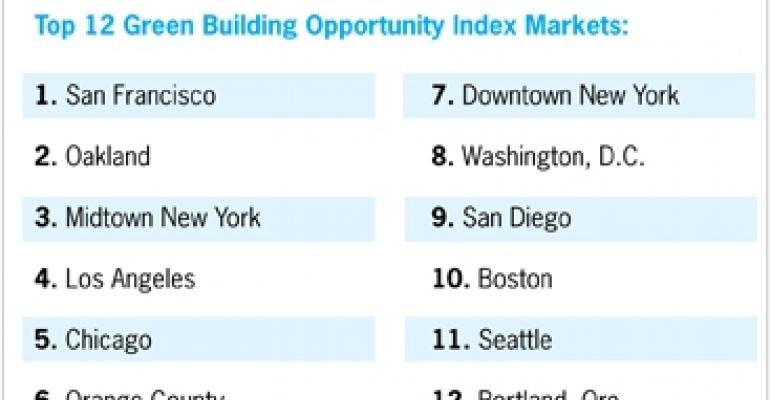San Francisco leads the 25 largest office markets for green opportunities, according to a study just released by global real estate company New York-based Cushman & Wakefield, in collaboration with the Northwest Energy Efficiency Alliance’s BetterBricks initiative, based in Portland, Ore.

The Green Building Opportunity Index is the first office market assessment tool to provide weighted comparisons of top United States office markets on the basis of both real estate fundamentals and green development considerations, according to Cushman & Wakefield .
The index focuses on the primary factors that influence successful development, retrofitting, leasing and sales of investment-grade green office buildings in the 25 largest U.S. CBDs. It compares a market’s relative position to its peers in six categories: office market conditions, investment outlook, green adoption and implementation, local mandates and incentives, state energy initiatives and green culture.
The Green Building Opportunity Index comes on the heels of the EPA’s list of Top 25 U.S. cities for energy-efficient buildings, with many of the same cities on both lists. The EPA ranking, however, lists only the number of Energy Star-labeled buildings in each city. The Green Building Opportunity Index ranks each market on dozens of different factors, in addition to the number of Energy Star-labeled and LEED-certified buildings.
“These results highlight the importance of both public and private entities considering market economic opportunities hand-in-hand with the incentives, policies and cultural considerations that are critical for green building,” said Theddi Wright Chappell, managing director and national practice leader of Cushman & Wakefield’s green building and sustainability practice in a statement. “If it’s not financially sustainable, it’s not sustainable.”
As a tool to examine the overall climate for green building, the index will help to determine where the favorable conditions exist for green buildings. Investment and pension fund managers, and developers can use this data to consider where to put their money and why.
City policy makers, utility staff and planners can examine the data to understand what new policies and incentives might be useful to accelerate green building activity. Building owners, architects and green building consultants can determine where green development brings competitive advantages, or where it is simply an emerging standard.
“This is the first study that meshes real estate market data with green building policy, incentive and cultural data,” said Jack Davis, market manager for office real estate for the BetterBricks initiative. “This research highlights many of the market features and conditions that can accelerate or impede green building adoption.”

